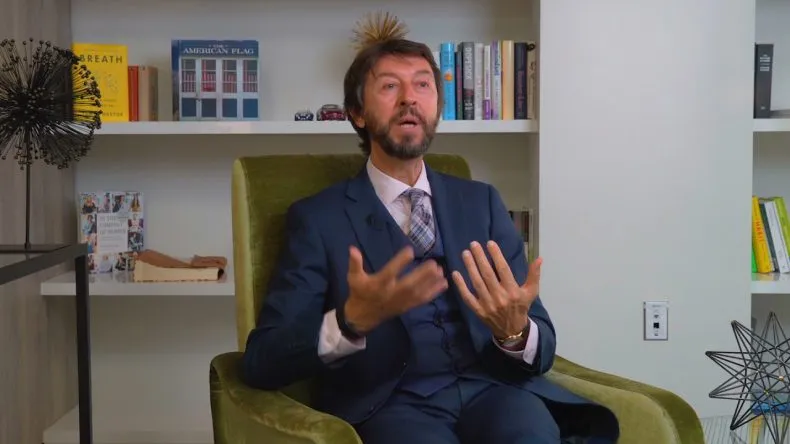Worldwide, 280 million people suffer from depression, making it one of the most widespread mental health problems. For decades, medical professionals have been trying to find fool-proof depression treatment that consistently works.
- What Is TMS
- How Does TMS Treat Anxiety
- TMS Therapy For Anxiety
- Effectiveness Of TMS
- Side Effects Of TMS
- Can TMS Make Anxiety Worse
- The Case For Tms For Depression
- Does Tms Therapy Work For Treatment Resistant Depression
- What To Expect During A Tms Therapy Session For Depression
- How To Prepare For Tms Therapy Session
- Tms Therapy For Depression At GIA Boca
- Seek Tms Therapy For Depression Today
From antidepressant medications and therapy to green prescriptions, many people try various treatments to see what works best for them. Yet, a large proportion of clients overlook TMS therapy for depression.
Used to treat a range of mental health conditions, including major depressive disorder and post-traumatic stress disorder (PTSD), TMS might just hold the key to curing depression for good. Here, we take a closer look at what TMS therapy is and its benefits.
What Is TMS Therapy for Depression?
First introduced by Anthony Baker in 1985, transcranial magnetic stimulation (TMS) therapy was designed to activate neurons in the prefrontal motor cortex with the aim of curing depression. A non-invasive form of brain stimulation, transcranial magnetic stimulation was the first of its kind to activate brain stimulation and improve symptoms, all without any pain or direct interference to the body.
Unlike electroconvulsive therapy, transcranial magnetic stimulation doesn’t require any anesthesia, and it only uses low magnetic pulses to stimulate brain activity. Repetitive transcranial magnetic stimulation, or repetitive TMS, is another word for TMS that highlights how long a typical course of treatment is. It ranges from four to six weeks and is a repetitive form of therapy. However, the exact length of treatment will vary from person to person.
TMS works because it triggers brain activity in the prefrontal cortex. Why does this help? Most people that suffer from depression or other mood disorders often have lower levels of brain activity, so by triggering activity and stimulation in the prefrontal cortex, TMS therapy essentially regulates emotions and helps relieve symptoms.
How Does Transcranial Magnetic Stimulation Work?
TMS therapy helps relieve symptoms by targeting the part of the brain that helps regulate mood (the dorsolateral prefrontal cortex). Electromagnetic pulses are delivered to this central location, helping to stimulate nerve cells and trigger brain stimulation. Since TMS targets the prefrontal cortex, it is thought to improve symptoms of depression and other mental health disorders, including anxiety.
How Long Is TMS treatment for depression?
TMS therapy is an ongoing procedure performed over four to six weeks. Sessions generally last between thirty to forty minutes, with clients attending treatment five days a week. Though TMS produces little to no side effects, clients sometimes ask someone to accompany them to their appointment until they feel comfortable enough to attend independently.
Who Will Carry Out the TMS Treatment?
A fully vetted TMS technician carries out all TMS treatments. These technicians set up the equipment and conduct the treatment, sending magnetic pulses to the brain. If a client begins to feel uncomfortable or decides they want to stop the treatment, they can do so by asking the TMS technician.
What Is Depression?
Depression is a common mental illness that affects the way people think and feel, often causing emotions such as sadness and hopelessness to arise. Other depression symptoms include:
- A lack of interest or withdrawal from social activities
- A lack of motivation or inspiration to complete everyday tasks
- Feeling irritable
- Thoughts surrounding suicide or self-harm
- Problems with work, life, and friendships
- Finding it difficult to make decisions and go about day-to-day life
Depression can also present a range of physical symptoms, including:
- A loss of appetite or increased appetite
- Insomnia or sleeping problems
- A low libido (lower sex drive)
- Irregular menstrual cycles
- Aches and body pains
- Delayed motor responses
- Feelings of lethargy
Despite the complexities, it is entirely possible to treat depression. Standard treatments usually include things like talk therapy and medication, but transcranial magnetic stimulation (TMS) delivers a fresh new alternative.
What Causes Depression?
Most people think depression is a chemical imbalance in the brain, but it can actually stem from a variety of factors, such as:
- History of mental health disorders
- Traumatic life events, such as divorce, loss of a loved one, redundancy, or financial troubles
- Childhood trauma
- Other medical conditions, such as life-threatening illnesses or long-term diseases
- Drug or alcohol addiction
- Overall health and well-being problems, such as a lack of sleep, a lousy diet, and limited exercise
- Pregnancy
- Isolation
Though there’s no set cause, major depressive disorder can be treated. As an entirely non-invasive form of treatment, TMS is nothing like other brain stimulation therapies, such as electroshock therapy or electrical stimulation treatment (ECT).
The Case for TMS for Depression
Unlike other forms of treatment for major depression, including electroconvulsive therapy (ECT) and medication, both of which can have lingering side effects, one of the great things about transcranial magnetic stimulation is that it has little to no impact on the body.
Aside from potential weight gain and mood swings associated with medication, ECT can be uncomfortable and painful at times. In contrast, repetitive transcranial magnetic stimulation (rTMS) is a completely non-invasive form of treatment and is as safe as an MRI machine.
Though the benefits of TMS continue to be researched by scientists, recent studies have shown its effectiveness in reducing depressive symptoms. The theory behind its success points to the magnetic pulses that are delivered to nerve cells in the brain via pulses. This triggers brain stimulation in the prefrontal cortex, which is thought to help regulate emotions, get the brain involved in stimulation, and boost moods in those who may have found other treatments to be ineffective.
A Harvard study shows that approximately 50% to 60% of people with depression experience a positive change after TMS, with some even going into complete remission and never experiencing symptoms again.
In most cases, clients began to experience symptom relief from depression after around three months.
Does TMS Therapy Work for Treatment-Resistant Depression?
TMS therapy is approved by the US Food and Drug Administration for the treatment of major depressive disorders. Although around 300 million people worldwide suffer from depression, traditional therapeutic approaches, such as medication or psychotherapy, are not always practical. In this case, the condition is called treatment-resistant depression.
The American Psychiatric Association has indicated that TMS for treatment-resistant depression is highly beneficial. As a safe, painless, and non-invasive approach, it works well in combination with other treatments for depression, with multiple trials and studies showing its effectiveness.
What To Expect During a TMS Therapy Session for Depression
Since transcranial magnetic stimulation is painless, it doesn’t require anesthesia. This makes it a welcome alternative for many clients who have experienced ECT or have had to take heavy medication.
TMS therapy is a simple procedure delivered by a certified TMS physician on a recurring basis for up to six weeks. However, some people may not require treatment for this long, whereas others may. Typically, a TMS session lasts anywhere between thirty to forty minutes.
During TMS treatment sessions, the following happens:
- A TMS physician places an electromagnetic coil at the side of the client’s head.
- A TMS technician measures the client’s motor threshold – the amount of magnetic energy needed to make their thumbs twitch – to ensure that each TMS session is personalized to their individual needs.
- The magnetic coil is then placed directly over the client’s brain.
- Painless magnetic pulses are delivered to the prefrontal cortex, stimulating brain activity and nerve cells.
During a repetitive transcranial magnetic stimulation session, it is common for those undergoing treatment to hear clicking sounds and feel a slight tapping sensation. Although this can be surprising, it is entirely normal and is just the sound of the electromagnetic coil delivering pulses to brain cells in the motor cortex.
In the event that a client feels uncomfortable during treatment, the TMS technician can pause or stop treatment and answer any questions.
How To Prepare for TMS Therapy Session
Though TMS is a simple procedure, there are a few things that clients need to do ahead of their scheduled session. This may include taking a physical or psychiatric exam to help doctors better understand the state of their mental health.
It is also important to note that not everyone will be able to undergo TMS therapy. Unfortunately, TMS therapy cannot be offered if:
- The client is pregnant.
- The client has a metal object implanted inside their body, such as dental fillings, bullet fragments, aneurysm clips, cochlear hearing implants, or any other metal implants.
- The client is taking extra medication.
- The client suffers from brain damage or brain-related injury.
- The client has a genetic history of seizures and epilepsy.
TMS Therapy for Depression at GIA Boca
At GIA Boca, we are dedicated to providing depression treatments to help our clients get their lives back on track. We firmly believe that a mental health condition, such as depression, does not have to hold anyone back.
Located in the heart of Boca, we offer a relaxed and luxurious space to de-stress and focus on recovery. All of our clients are treated with the respect and autonomy they deserve, and we work with them to create a bespoke package that suits their needs.
We know just how difficult living with major depression can be, so we have pioneered a new and effective treatment for those suffering from depression and anxiety disorders. Alongside talk therapy and medication, we also offer TMS therapy to those who would like to take advantage of it. All treatment sessions are performed by vetted technicians and are a quick and painless alternative to more traditional brain stimulation therapies.
Catering to a wide range of mental health disorders and addictions, we also treat bipolar disorder, obsessive-compulsive disorder, and substance abuse issues.
Seek TMS Therapy for Depression Today
Session through our admissions process. To find out more about TMS therapy or our facilities, call us at (561) 464-6811 today.









